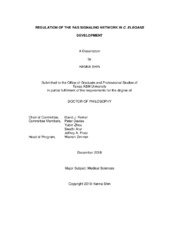| dc.description.abstract | An EGF gradient induces the equipotent C. elegans vulval precursor cells (VPCs) to assume the 3˚-3˚-2˚-1˚-2˚-3˚ pattern of cell fates. EGF triggers the LET-60/Ras-LIN-45/Raf-MEK-2/MEK-MPK-1/ERK canonical MAP kinase cascade to induce 1˚ fate and synthesize of DSL ligands for the lateral Notch signal. In turn, LIN-12/Notch induces neighboring cells to become 2˚. In response to lower dose of EGF signal, LET-60/Ras switches effectors to use the RGL-1/RalGEF-RAL-1/Ral modulatory signaling cascade to promote 2˚ fate in support of LIN-12. The goals of this research are to define principles by which signaling networks function and to identify an effector cascade downstream of RAL-1. RAL-1 signals through EXOC-8/Exo84, an established Ral binding partner, GCK-2, a CNH domain-containing MAP4 Kinase, and PMK-1/p38 MAP kinase to promote 2˚ fate. We also show that RGL-1 plays opposing and genetically separable roles in VPC fate patterning. RGL-1 promotes 2˚ fate via canonical GEF-dependent activation of RAL-1 and 1˚ fate via a non-canonical GEF-independent activity. Our genetic epistasis experiments are consistent with RGL-1 functioning in the modulatory 1˚-promoting AGE-1/PI3-Kinase-PDK-1/PDK-AKT-1/Akt cascade. Animals without RGL-1 experience 15-fold higher rates of VPC patterning errors compared to the wild type. Yet VPC patterning in RGL-1 deletion mutants is not more sensitive to environmental perturbations. We propose that RGL-1 functions as a “Balanced Switch” that orchestrates opposing 1˚- and 2˚-promoting modulatory cascades to decrease developmental stochasticity. To investigate how LET-60/Ras switches effectors to promote different cell fates, we used CRISPR to tag endogenous LIN-45/Raf and RGL-1/RalGEF proteins. We found that they are recruited to different subcellular compartments during VPC induction. LIN-45 is recruited to the basolateral membrane in presumptive 1˚ cells. RGL-1 is recruited to the apical membrane in presumptive 2˚ cells, and this localization depends on functional LET-60. We hypothesize that RGL-1 apical localization in the VPCs is mediated by phosphorylation or scaffold proteins. Our studies delineate a novel Ral-dependent developmental signaling cascade, bifunctional RGL-1 as a “Balanced Switch”, and LET-60 effector segregation mechanism in vivo, thus providing critical insights for understanding Ras biology in cancer and development. | en |


